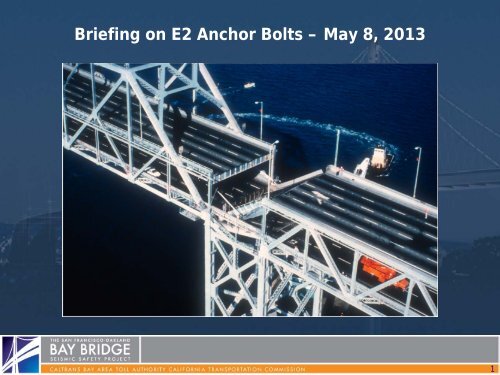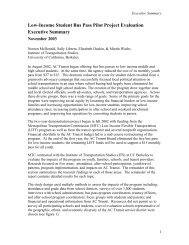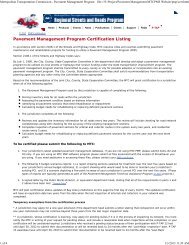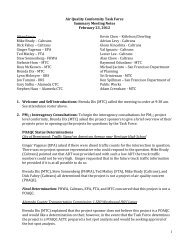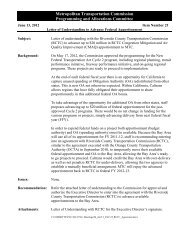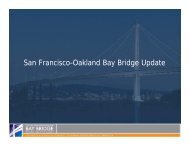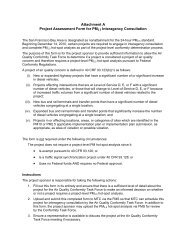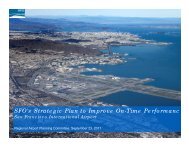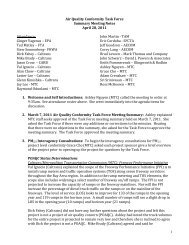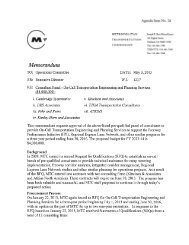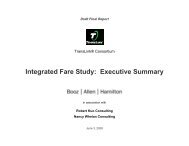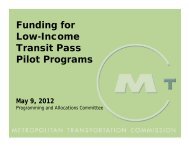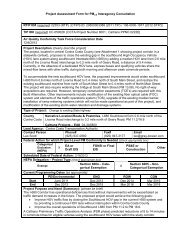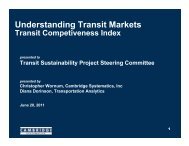Hydrogen Embrittlement
Hydrogen Embrittlement
Hydrogen Embrittlement
Create successful ePaper yourself
Turn your PDF publications into a flip-book with our unique Google optimized e-Paper software.
Briefing on E2 Anchor Bolts – May 8, 2013<br />
1
Four Key Questions<br />
1. What caused the E2 anchor bolts manufactured<br />
in 2008 to fail?<br />
2. What retrofit strategy should be used to replace<br />
the 2008 anchor bolts?<br />
3. Should the remaining bolts on the E2 pier<br />
manufactured in 2010 be replaced?<br />
4. What should be done about other similar bolts<br />
on the SAS?<br />
2
Pier E2<br />
3
Oversight Structure<br />
Toll Bridge Program Oversight Committee<br />
CALTRANS BATA CTC<br />
Seismic Peer<br />
Review Panel<br />
Contractors<br />
BAMC for BATA<br />
Oversight<br />
4
Toll Bridge Program Oversight Committee<br />
AB 144 established the Toll Bridge Program<br />
Oversight Committee, composed of Director of<br />
the California Department of Transportation<br />
(Caltrans), and the Executive Directors of the<br />
California Transportation Commission (CTC) and<br />
the Bay Area Toll Authority (BATA), to be<br />
accountable for delivering the Seismic Retrofit<br />
Program.<br />
MALCOLM DOUGHERTY<br />
Director<br />
California Department of<br />
Transportation<br />
STEVE HEMINGER<br />
Executive Director<br />
Bay Area Toll Authority<br />
ANDRE BOUTROS<br />
Executive Director<br />
California Transportation<br />
Commission<br />
5
Toll Bridge Seismic Peer Review Panel<br />
• Dr. Frieder Seible, Dean Emeritus of the Jacobs School of Engineering at<br />
the University of California at San Diego, has consulted on many of the<br />
world's long-span bridges and has extensively published related to seismic<br />
design and blast resistant design of critical structures.<br />
• Dr. I.M. Idriss, Emeritus Professor of Civil Engineering at the University of<br />
California at Davis , is a Geotechnical Engineer who has performed followup<br />
analysis of every major earthquake since the 1964 Alaska quake and<br />
has been part of numerous engineering teams to analyze damage and<br />
determine causes of structural collapse.<br />
• Dr. John Fisher, Professor Emeritus of Civil Engineering at Lehigh<br />
University, has focused his research on the behavior and performance of<br />
steel bridges and has examined most of the major failures of steel<br />
structures in America throughout the last four decades, including the<br />
World Trade Center in 2001.<br />
• All three are members of the National Academy of Engineering.<br />
6
FHWA Independent Review<br />
The TBPOC has requested that the<br />
Federal Highway Administration (FHWA)<br />
conduct an additional independent review<br />
of our findings and recommendations<br />
concerning the bolts on the SAS.<br />
7
1. What caused the E2 anchor<br />
bolts manufactured in 2008 to<br />
fail?<br />
8
B1 S1 B2 S3 S4 B3 S2 B4<br />
• Bearings and shear keys are secured to E2 by 3 inch diameter<br />
bolts, ranging from 9 feet to 24 feet in length and to the OBG<br />
by 2 to 3 inch diameter bolts ranging 2 to 5 feet in length.<br />
• 96 bolts manufactured in 2008 shown in red are embedded in<br />
the pier.<br />
9
Failure of 2008 Bolts Due to <strong>Hydrogen</strong><br />
<strong>Embrittlement</strong><br />
As determined by<br />
Caltrans and the<br />
Contractor, the<br />
anchor bolts failed<br />
as a result of<br />
hydrogen<br />
embrittlement.<br />
10
Tension<br />
<strong>Hydrogen</strong> <strong>Embrittlement</strong><br />
<strong>Hydrogen</strong><br />
Susceptibility<br />
<strong>Hydrogen</strong><br />
embrittlement requires<br />
three elements<br />
Susceptibility<br />
<strong>Hydrogen</strong><br />
Tension<br />
Root cause of the<br />
failure is attributed to<br />
higher than normal<br />
susceptibility of the<br />
steel to hydrogen<br />
embrittlement.<br />
11
<strong>Hydrogen</strong> <strong>Embrittlement</strong><br />
1000X Magnification<br />
Metallurgical analysis shows a lack of uniformity in the<br />
microstructure of the steel, with large differences in<br />
hardness from center to edge and high local hardness near<br />
surface. Further, the material exhibited low toughness and<br />
marginal ductility.<br />
12
Report Recommendation<br />
Procurement of future A354 grade BD<br />
anchor rods should include a number of<br />
supplemental requirements to assure<br />
against hydrogen embrittlement failure.<br />
13
Specifications for Galvanized A354 BD Bolts<br />
A technical design specification team evaluated the bridge design and<br />
selected A354 BD bolts for this application.<br />
The design specification team subsequently added a supplemental<br />
requirement – blasting instead of pickling – to address the potential for<br />
hydrogen embrittlement.<br />
Current Caltrans Bridge specifications do not allow the use of galvanized<br />
A354 bolts for standard bridge applications, but non-standard<br />
applications may be considered. ASTM does allow galvanization, but<br />
cautions on the potential for hydrogen embrittlement.<br />
Caltrans has ordered a limited number of replacement bolts for the 2010<br />
bolts subjected to destructive testing. The special provisions of the<br />
specifications for those replacements rods include, but is not limited to,<br />
tighter requirements for hardness and additional testing to address<br />
hydrogen embrittlement. In hindsight, these supplemental specifications<br />
should have been in place for the 2008 bolts.<br />
14
2. What retrofit strategy should<br />
be used to replace the 2008<br />
anchor bolts?<br />
15
Option 1 – Steel Collar<br />
16
Option 2 – Steel Saddle<br />
17
General Comparison of Options<br />
Option 1 – Steel Collar<br />
Pros<br />
• No need to remove S1 and S2<br />
shear keys<br />
• Potentially simpler to fabricate<br />
Cons<br />
• Need to find sufficient<br />
materials and resources<br />
• More coring of E2 required<br />
• More costly: $15 to 20 m<br />
Option 2 – Steel Saddle<br />
Pros<br />
• No need to remove S1 and S2<br />
shear keys<br />
• Less coring of E2 required<br />
• Potentially less difficult to<br />
install.<br />
• Less costly: $5 to 10 m<br />
Cons<br />
• Requires unique saddle<br />
system.<br />
18
Selection of Option 2 - Saddle<br />
Both options would provide equivalent clamping force as the<br />
original bolt design to hold down the shear keys. The 2008 bolts<br />
will be completely abandoned in both options.<br />
Option 2 has been selected as the retrofit strategy for the 2008<br />
bolts because while requiring more detailed fabrication,<br />
installation will be less difficult and require less coring of<br />
concrete on Pier E2.<br />
Estimated cost to construct Option 2 is $5 to 10 m.<br />
Given the complexities of the retrofit, Caltrans is still working<br />
with the Contractor to determine if the retrofit can be completed<br />
by Labor Day.<br />
19
3. Should the remaining bolts on<br />
the E2 pier manufactured in<br />
2010 be replaced?<br />
20
B1 S1 B2 S3 S4 B3 S2 B4<br />
• 96 bolts manufactured in 2008 shown in red are embedded in the pier.<br />
• 192 bolts manufactured in 2010 shown in yellow are not embedded in pier.<br />
• 544 bolts manufactured in 2010 shown in green are connected to the OBG.<br />
• There are an additional 432 bolts of 1 inch diameter, varying from 2 inches<br />
to 2 feet in length, that are internal to the E2 bearing assembly.<br />
21
Preliminary 2010 Bolt Results<br />
No bolts have broken after<br />
more than a month of<br />
tensioning.<br />
Preliminary test results for<br />
2010 bolts, including full<br />
sized destructive testing,<br />
show more ductile material<br />
properties and no hydrogen<br />
embrittlement.<br />
Additional testing results are<br />
anticipated, including<br />
surface hardness, toughness,<br />
microscopic examination,<br />
and corrosion testing<br />
22
ASTM<br />
Requirements<br />
D>2 ½”<br />
2008 E2 Bottom<br />
Average<br />
2010 E2 Bottom<br />
Average<br />
E2 Shear Key<br />
Top Average<br />
ASTM<br />
Requirements<br />
D = ¼” to 2 ½”<br />
E2 Bearing Top<br />
Average<br />
E2 Bearing<br />
Assembly<br />
Average<br />
E2 Retaining<br />
Ring Average<br />
Tensile<br />
(KSI)<br />
Yield<br />
(KSI)<br />
Elongation<br />
(%)<br />
Reduction of<br />
Area<br />
(ROA)<br />
Hardness<br />
(HRC)<br />
Charpy<br />
Toughness<br />
(ft-lb)<br />
140 (min) 115 (min) 14 (min) 40 (min) 31-39 N/A<br />
164 142 14 48 37 @40° - 13.5<br />
@70° - 16.2<br />
159 139 16 51 34 @40° - 37.2<br />
@70° - 37.7<br />
159 141 16 46 35 N/A<br />
150 (min) 130 (min) 14 (min) 40 (min) 33-39 N/A<br />
161 135 16 54 35 N/A<br />
166 154 18 56 36 N/A<br />
166 148 16 50 35 N/A<br />
Post Heat Treatment QC/QA Mechanical Tests at E2<br />
23
Wet Testing of 2010 Bolt Results<br />
A “wet” test is an accelerated test being<br />
prepared to determine the longer term<br />
susceptibility of the material to stress corrosion.<br />
Full sized bolts will be soaked in a controlled<br />
concentrated salt solution while tensioned<br />
progressively over a number of days until failure.<br />
Data from this test will be used to determine the<br />
susceptibility of the material to stress over time<br />
and under various loads.<br />
24
Long term stress corrosion<br />
susceptibility is a function<br />
of the size and hardness of<br />
material, and level of<br />
tensioning.<br />
With the “wet” testing<br />
data, staff will be able to<br />
evaluate all similar highstrength<br />
bolts used on the<br />
project and help<br />
determine if additional<br />
remedial action is needed.<br />
Stress Corrosion<br />
Sample Critical Stress Curve from Guide to<br />
Design Criteria for Bolted and Riveted Joints 2 nd<br />
Edition authored by Geoffrey Kulak, John Fisher,<br />
and John Struik and published by American<br />
Institute of Steel Construction<br />
25
4. What should be done about<br />
other similar bolts on the SAS?<br />
26
• Visual inspections of similar bolts revealed they are performing as<br />
required.<br />
• Some E2 Bearing assembly bolts are not accessible to inspection.<br />
• Most bolts at other locations are under lower tension levels.<br />
27
Other Similar Bolts<br />
Location Item No. Description Diameter (in) Length (ft)<br />
E2<br />
Quantity<br />
Installed<br />
Tension<br />
(fraction of<br />
Fu)<br />
1 2008 Shear Keys Bolts 3 10 – 17 96 0.7<br />
2 2010 Shear Keys and Bearing Bolts 3 22 - 23 192 0.7<br />
3 Upper Shear Key OBG Connections 3 2 - 4.5 320 0.7<br />
4 Upper Bearing OBG Connections 2 4 224 0.7<br />
5 Bearing Assembly Bolts for Bushings 1 2.5 96 0.6<br />
6 Bearing Assembly Bolts for Retaining Rings 1 0.2 336 0.4<br />
Anchorage 7 PWS Anchor Rods 3.5 28 – 32 274 0.4<br />
Top of Tower<br />
Bottom of Tower<br />
East Saddles<br />
8 Saddle Tie Rods 4 6.0 – 18 25 0.4<br />
9 Saddle Segment Splices 3 1.5 – 2 108 0.1 - 0.5<br />
10 Saddle to Grillage Anchor Bolts 3 1 90 0.1<br />
11 Outrigger Boom 3 2 4 0.1<br />
12 Anchor Rods 3" 3 26 388 0.5<br />
13 Anchor Rods 4" 4 26 36 0.4<br />
14 East Saddle Anchor Rods 2 3 32 0.1<br />
15 East Saddle Tie Rods 3 5 18 0.1<br />
East Cable 16 Cable Bands 3 10 - 11 24 0.2<br />
W2 17 Bikepath Anchor Rods 1 3/16 1.5 43 tbd<br />
TOTAL 2306<br />
28
Other Toll Bridges<br />
As part of this investigation, the TBPOC has<br />
asked Caltrans to review other toll bridges which<br />
may have used similar bolts.<br />
Caltrans has already identified locations of<br />
similar A354 BD galvanized bolts on the<br />
Richmond-San Rafael Bridge and completed<br />
initial inspections.<br />
No issues have been found and bolts are<br />
performing as required.<br />
29
Items Expected From Briefing at<br />
Special May 29 th BATA Meeting<br />
Pending results from testing of 2010<br />
bolts, decision on whether to replace<br />
other Pier E2 bolts and, if so, when.<br />
Completion of desk review of additional<br />
QA/QC results for other high tension<br />
anchor bolt locations.<br />
30


